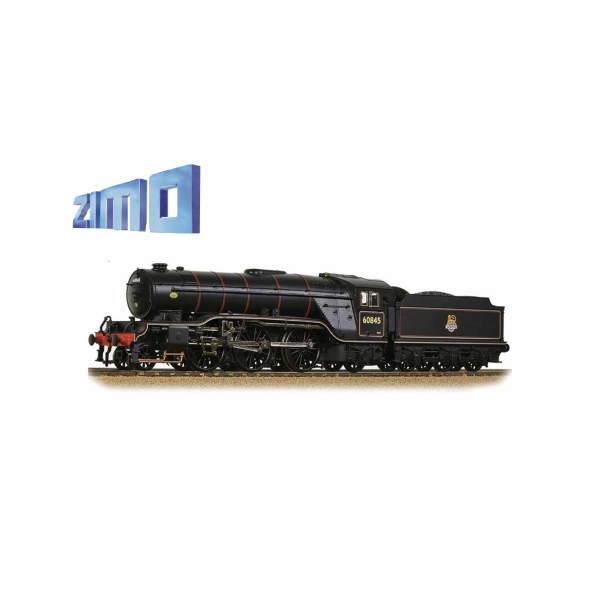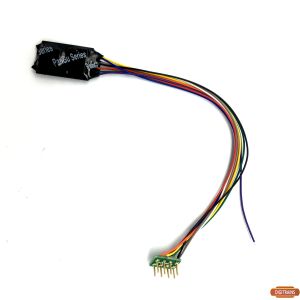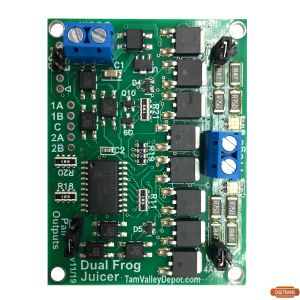ZS050P LNER 3 Cylinder V2 ZIMO Proto-Drive V21.12
Please spend a few moments to read these notes which have been produced so that you may obtain the maximum satisfaction from your new sound scheme.
What is Proto-Drive?
This is a system developed to allow you, the user, to change the way that the sounds respond to your driving style or needs. This avoids the need for reprogramming and all the additional costs that would imply.
Operating Your ZIMO Sound Decoder.
As supplied, your new decoder will work in a ‘heavy train’ configuration, but you will be able to switch between the available sounds using your DCC controller by following the straightforward instructions below.
This project utilises Zimo’s ability to switch between the sounds of a heavy train load or sounds of a light engine.
These are all fully configured within the project, waiting for you to make your choice.
You can revert at any time.
All the CVs have been optimised but you may need to make minor adjustments to perfect it for your individual tastes.
There are many Functions, most of which have an individual sound attached. Some will perform a physical function (like turning on the lamps, if fitted), and some will do both (depending on equipment installed). Please study the list below.
Some of the sounds have a finite length and will play from start to finish when selected. Other sounds will ‘loop’ until switched off, whilst others will vary in length, depending on how you operate the F keys on your DCC controller. I’ll leave you with the pleasure of finding out which is which.
In any of the driving sound sets, increasing the speed step by 1 or more will produce an acceleration sound for a few seconds. If you wish continuous acceleration, ease the throttle setting upwards rather than 0- 128 in one jump!
Similarly, in each sound set, a reduction of 1 speed step or more will stop the exhaust beats and the loco will ‘coast’ (or drift) for a few seconds before resuming exhaust beats. Continuous drifting can be simulated by easing the throttle settings down, one step at a time.
All sounds may be modified (including changing or removing them) individually, and the volume levels of each one may also be varied to your own needs. For this, and much more information on your decoder’s outstanding abilities, please download the latest Decoder Manual from: www.zimo.at/web2010/
You can get advice in English by joining, for free: [email protected]
Special Zimo Function on F5.
As supplied, it is possible to toggle between Set 1 and Set 2 (change from one to the other and back again) and this may be done even whilst the loco is moving, with no loss of sound. This is useful to vary the sound of the exhaust beats. But it really comes into its own when you run light loco up to a train, couple up and chug away with the heavy sounds.
All you need to do to make this happen is to press F5 on your DCC controller, and press again to change back. Set 1 Heavy Loaded. Set 2 Light Engine.
Heavy Mode
This is the default setting. Inertia and momentum have high settings to reflect the high mass of a loaded train. Maximum power would be required on a real loco to lift a heavy train. This means that as well as opening the regulator, the driver would allow maximum steam into the cylinders with the reverser fully open.
During acceleration, the exhaust beats will bark aggressively, but the tone and volume will soften after a few seconds as the real driver would advance the steam cut-off to reduce steam entering the cylinders, increasing the efficiency of the engine.
Light Engine Mode
The default setting is for ‘heavy train’.
Engaging F key 5 will switch the exhaust sounds to a different set of samples, so the ‘chuffing’ is less aggressive in nature and quieter. This represents the reduced ‘cut-off’ on the reverser on real locos.
The Inertia and Momentum settings are automatically reduced when Light Engine Mode is selected. The physical characteristics are changed so the model responds more urgently to control inputs. Acceleration is more brisk and stopping distance is reduced.
Dynamic Inertia
In either Heavy or Light modes, flipping the throttle quickly to high speed steps will cause the model to accelerate 3 times more quickly from standing than if the throttle is gradually opened. This is automatic, no F keys are involved.
So now, the rate of acceleration is determined by how wide you open the regulator, just as it would on a real locomotive.
Brakes
F2 will give the sound of brake applications. F2 can be ‘dabbed’ or held for varying durations. The sound will respond accordingly.
However, if the throttle is reduced in advance, as a real driver would do before operating the Brake Key, a braking force will be applied which will continue to increase the longer F2 is held. Short dabs will provide speed trimming, held down continuously will result in a controlled ‘Emergency Stop’.
Live Volume Control
Provide the sound is switched on and the ‘fade’ button is not active, it is possible to change the overall volume to suit changing needs.
Engage F27 and the sound levels will gradually reduce, eventually to silence
Engage F28 and the sound levels will gradually increase, eventually to maximum.
In each case, disengage the F key when the desired level is attained. Set F27 and F28 as ‘momentary’ if your DCC controller allows you to do so.
Note: If the volume controls appear to not function, check that F18, F27 and F28 are disengaged before making a further attempt. Then try a CV8 to 8 reset.
Function Keys List
There are 26 Function Keys used in this sound project. Please see below.
Some of the sounds have a finite length and will play from start to finish when selected. Other sounds will ‘loop’ until switched off, whilst others will vary in length, depending on how you operate the F keys on your DCC controller.
Some keys have a control function rather than a sound.
Functioning Handbrake
By turning on Function 11 you activate a working handbrake. The loco WILL NOT MOVE WITH F11 ACTIVE. If try to move away with this active, you get an engineer shouting “handbrake on!”. A sound plays for both applying the handbrake and releasing the handbrake. Again, the model WILL NOT MOVE WITH F11 ACTIVE.
Coupling Sequence
By turning on Function 14 you activate a coupling up Sequence. The locomotive will start to move in the direction set, and a buffering up sound will play. After this, the loco will come to a stop by itself and wait for a few seconds and play a coupling up sound. At this point if you wish to pull the train the YOU MUST CHANGE DIRECTION ON YOUR CONTROLLER. As you start to move away, the sound of the train taking the slack will play.
Useful CVs
CV8 – Write to a value of 8 for a reset, this does not lose any sounds.
CV266 – Adjustment for overall volume.
CV267 – Adjustment of Chuff rate.
CV285 – Rod Clank Volume.
|
Key Number
|
Sound or Control Function
|
|
F0
|
Loco Lamps (If Fitted)
|
|
F1
|
Sound ON
|
|
F2
|
Brake Key – see text for explanation
|
|
F3
|
Whistle (Speed Dependant)
|
|
F4
|
Whistle (Speed Dependant)
|
|
F5
|
Heavy Train/Light Engine Selection
|
|
F6
|
Coal Shovelling (This sound is also a random sound) + Firebox Flicker
|
|
F7
|
Injector
|
|
F8
|
Blower
|
|
F9
|
Wheel Flange
|
|
F10
|
Whistle (Speed Dependant)
|
|
F11
|
Functioning Handbrake
|
|
F12
|
Guard’s Whistle
|
|
F13
|
Buffering up
|
|
F14
|
Coupling Up Sequence
|
|
F15
|
Cylinder Drains Opened
|
|
F16
|
Waterfilling
|
|
F17
|
Station Announcements
|
|
F18
|
Mute Sounds
|
|
F19
|
Safety Valves
|
|
F20
|
Wagons Taking Slack
|
|
F21
|
Toot Whistle
|
|
F22
|
Toot Toot Whistle
|
|
F23
|
Toot Whistle
|
|
F24
|
|
|
F25
|
|
|
F26
|
|
|
F27
|
Overall Volume Down
|
|
F28
|
Overall Volume Up
|





